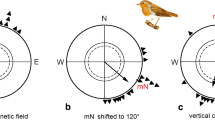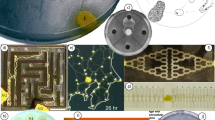Abstract
The antlion larvae (Myrmeleontidae) are ambush predators. They detect substrate-borne vibrations induced by the movement of the prey. European pit-building antlions (Myrmeleon inconspicuus) are studied for their ability to perceive vibrations generated by the locomotion of an ant (Cataglyphis cursor) outside the pit. These strides have been recorded and copied in detail in their time sequences. The signal created was emitted by piezoelectric transducers placed several centimeters outside the peripheries of the pits: the ant movements create waves with particle accelerations that are three orders of magnitude less than g, alleviating any possibility of sand avalanche towards the bottom of the pit. Depending on the amplitude of the vibrations, the antlions answer back, generally by sand tossing. One remarkable feature is the time delay between the start of the cue and the predatory behaviour induced by this cue. This time delay is studied versus the cue amplitude. We found that antlions answer back within minutes to cues with amplitudes of nanometer range, and within seconds to these same cues if they are preceded by a sequence of signals at the Ångström amplitude. This difference in latency is used to evidence the sensitivity to vibrations at an extremely low level.








Similar content being viewed by others
References
Andreotti B, Forterre Y, Pouliquen O (2013) Granular media: between fluid and solid. Cambridge University Press, Cambridge. https://doi.org/10.1017/CBO9781139541008
Barth FG (2002) A spider’s world, senses and behavior. Springer, Berlin, Heidelberg
Barth FG (2019) Mechanics to pre-process information for the fine tuning of mechanoreceptors. J Comp Physiol A 205(5):661–686
Bates D, Mächler M, Bolker B, Walker S (2015) Fitting linear mixed-effects models using lme4. J Stat Softw 67:1–48. https://doi.org/10.18637/jss.v067.i01
Borg E (1982) Auditory thresholds in rats of different age and strain. A behavioral and electrophysiological study. Hear Res 8:101–115. https://doi.org/10.1016/0378-5955(82)90069-7
Botz J, Loudon C, Barger J, Olafsen J, Steeples D (2003) Effects of slope and particle size on ant locomotion: implications for choice of substrate by antlions. J Kans Entomol Soc 76:426–435
Brownell PH (1977) Compressional and surface waves in sand: used by desert scorpions to locate prey. Science 197:479–482. https://doi.org/10.1016/0378-5955(82)90069-7
Cocroft RB, Gogala M, Hill PS, Wessel A (2014) Studying vibrational communication, animal signals and communication, vol 3. Springer, Berlin, Heidelberg. https://doi.org/10.1007/978-3-662-43607-3
Čokl A (1983) Functional properties of vibroreceptors in the legs of Nezara viridula (L.) (Heteroptera, Pentatomidae). J Comp Physiol A 150:261–269
Crassous J, Humeau A, Boury S, Casas J (2017) Pressure-dependent friction on granular slopes close to avalanche. Phys Rev Lett 119:058003. https://doi.org/10.1103/PhysRevLett.119.058003
Devetak D (1985) Detection of substrate vibrations in the antlion larva, Myrmeleon formicarius (neuroptera: Myrmeleonidae). Biol Vestn Glas Slov Biol 33:11–22
Devetak D (2005) Effects of larval antlions Euroleon nostras (neuroptera, myrmeleontidae) and their pits on the escape-time of ants. Physiol Entomol 30:82–86
Devetak D (2014) Sand-borne vibrations in prey detection and orientation of antlions. In: Cocroft RB, Gogala M, Hill PS, Wessel A (eds) Studying vibrational communication, animal signals and communication, vol 3. Springer, Berlin, Heidelberg, pp 319–330 chap 16
Devetak D, Špernjak A, Janžekovič F (2005) Substrate particle size affects pit building decision and pit size in the antlion larvae Euroleon nostras (neuroptera: Myrmeleontidae). Physiol Entomol 30:158–163. https://doi.org/10.1111/j.1365-3032.2005.00443.x
Eltz T (1997) Foraging in the ant-lion Myrmeleon mobilis Hagen 1888 (Neuroptera: Myrmeleontidae): behavioral flexibility of a sit-and-wait predator. J Insect Behav 10:1–11. https://doi.org/10.1007/BF02765471
Eriksson A, Anfora G, Lucchi A, Virant-Doberlet M, Mazzoni V (2011) Inter-plant vibrational communication in a leafhopper insect. PLoS ONE 6:e19692. https://doi.org/10.1371/journal.pone.0019692
Fertin A, Casas J (2007) Orientation towards prey in antlions: efficient use of wave propagation in sand. J Exp Biol 210:3337–3343. https://doi.org/10.1242/jeb.004473
Gepp J (2010) Ameisenlöwen und Ameisenjungfern. Westarp Verlagsservice, Germany
Griffiths D (1980) The feeding biology of ant-lion larvae: prey capture, handling and utilization. J Anim Ecol 49:99–125
Griffiths D (1986) Pit construction by ant-lion larvae: a cost-benefit analysis. J Anim Ecol 55:39–57
Guillette LM, Hollis KL, Markarian A (2009) Learning in a sedentary insect predator : antlions (Neuroptera : Myrmeleontidae) anticipate a long wait. Behav Process 80:224–232. https://doi.org/10.1016/j.beproc.2008.12.015
Hänggi P (2002) Stochastic resonance in biology: how noise can enhance detection of weak signals and help improve biological information processing. ChemPhysChem 3:285–290. https://doi.org/10.1002/1439-7641(20020315)3:3<285::AID-CPHC285>3.0.CO;2-A
Heinrich B, Heinrich M (1984) Pit construction by ant-lion larvae: a cost-benefit analysis. Behav Ecol Sociobiol 14:151–160
Hollis KL, Cogswell H, Snyder K, Guillette LM, Nowbahari E (2011) Specialized learning in antlions (Neuroptera: Myrmeleontidae), pit-digging predators, shortens vulnerable larval stage. PLoS ONE 6:e17958
Hollis KL, Harrsch FA, Nowbahari E (2015) Ants vs. antlions: an insect model for studying the role of learned and hard-wired behavior in coevolution. Learn Motiv 50:68–82
Holm S (1979) A simple rejective test procedure. Scand J Stat 6:65–70
Humeau A, Rougé J, Casas J (2015) Optimal range of prey size for antlions. Ecol Entomol 40:776–781. https://doi.org/10.1111/een.12254
Le Faucheux M (1972) Le rôle des soies thoraciques dans la capture des proies par la larve d’Euroleon nostras Fourcroy (névroptère). Revue du comportement animal 6:217–221
Lucas J (1982) The biophysics of pit construction by antlion larvae (myrmeleon, neuroptera). Anim Behav 30:651–664
Mencinger-Vračko B, Devetak D (2008) Orientation of the pit-building antlion larva Euroleon (Neuroptera, Myrmeleontidae) to the direction of substrate vibrations caused by prey. Zoology 111:2–8. https://doi.org/10.1016/j.zool.2007.05.002
Nowbahari E, Hollis KL, Durand JL (2012) Division of labor regulates precision rescue behavior in sand-dwelling Cataglyphis cursor ants: to give is to receive. PLoS ONE 7:e48516. https://doi.org/10.1371/journal.pone.0048516
Picton T (2010) Human auditory evoked potentials. Plural Publishing, San Diego
Principi MM (1943) Contributi allo studio dei neurotteri italiani. II. Myrmeleon inconspicuus Ramb. ed Euroleon nostras Fourcroy. Bull Insectol 14:131–192
R Core Team (2018) R: a language and environment for statistical computing. https://www.r-project.org/
Scharf I, Golan B, Ovadia O (2009) The effect of sand depth, feeding regime, density, and body mass on the foraging behaviour of a pit-building antlion. Ecol Entomol 34:26–33
Scharf I, David Barkae E, Ovadia O (2010) Response of pit-building antlions to repeated unsuccessful encounters with prey. Anim Behav 79:153–158. https://doi.org/10.1016/j.anbehav.2009.10.017
Scharf I, Lubin Y, Ovadia O (2011) Foraging decisions and behavioural flexibility in trap-building predators: a review. Biol Rev 86:626–639. https://doi.org/10.1111/j.1469-185X.2010.00163.x
Shaw SR (1994) Re-evaluation of the absolute threshold and response mode of the most sensitive know vibration detector, the cockroach’s subgenual organ: a cochlea-like displacement threshold and a direct response to sound. J Neurobiol 25:1167–1185. https://doi.org/10.1002/neu.480250911
Tillier P, Giacomino M, Colombo R (2013) Atlas de répartition des fourmilions de France. RARE, Supplément au tome XXII:1–51
Wilson D (1974) Prey capture and competition in the ant lion. Biotropica 6:187–193
Acknowledgements
We thank Pierre Tillier for indicating antlion locations in the forêt de Fontainebleau, Dušan Devetak for his precious help in the identification of the antlion species, Claudie Doums for providing Cataglyphis cursor ants, Paul Devienne for technical support, Karen Hollis for fruitful discussion, Fabrice Savarit and Patrizia d’Ettorre for academic support and Heiko G. Rödel for his contribution in the statistical analysis. This work was supported by the BQR 2014/2015 from the Université Sorbonne Paris Nord. V.M. acknowledges the support of the École doctorale Galilée - Université Sorbonne Paris Nord. Experiments complied with the principles of Laboratory Animal Care.
Author information
Authors and Affiliations
Corresponding author
Additional information
Publisher’s Note
Springer Nature remains neutral with regard to jurisdictional claims in published maps and institutional affiliations.
Electronic supplementary material
Below is the link to the electronic supplementary material.
Rights and permissions
About this article
Cite this article
Martinez, V., Nowbahari, E., Sillam-Dussès, D. et al. Antlions are sensitive to subnanometer amplitude vibrations carried by sand substrates. J Comp Physiol A 206, 783–791 (2020). https://doi.org/10.1007/s00359-020-01437-3
Received:
Revised:
Accepted:
Published:
Issue Date:
DOI: https://doi.org/10.1007/s00359-020-01437-3




